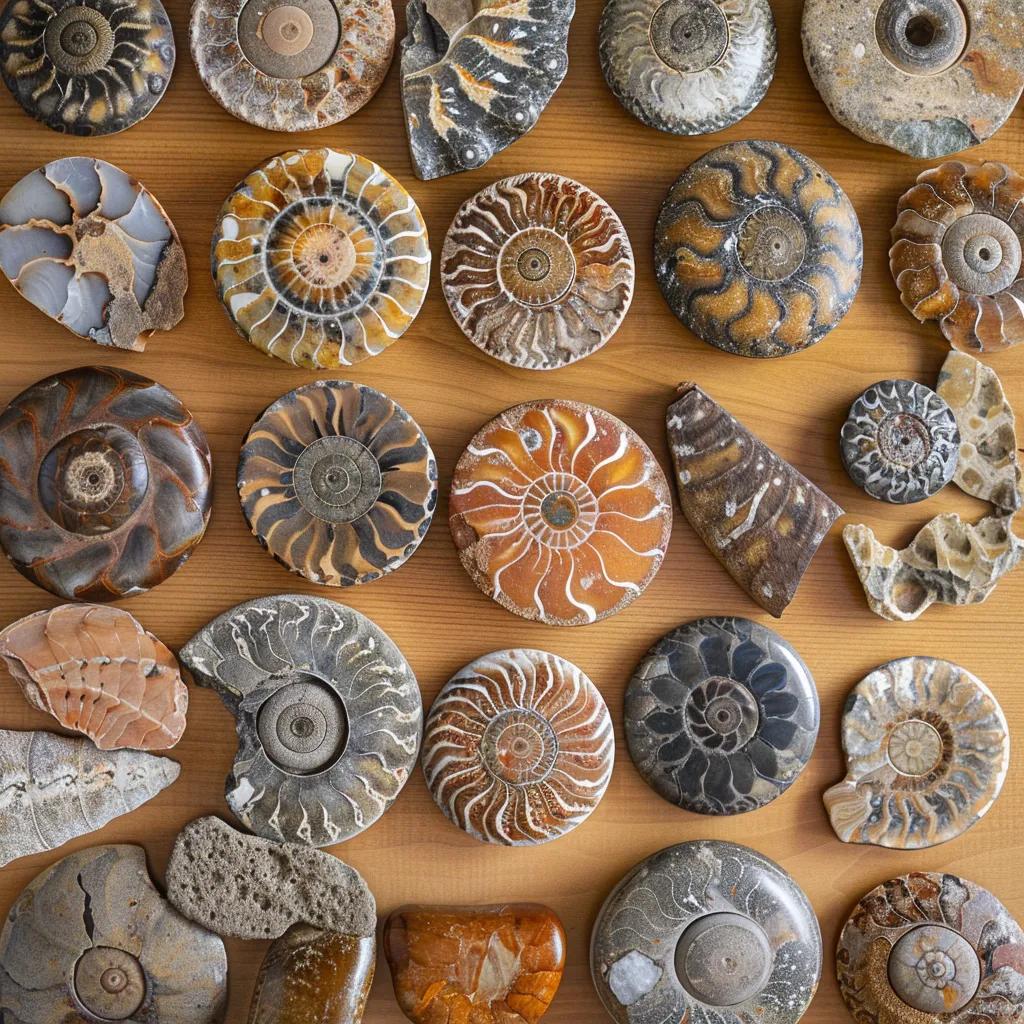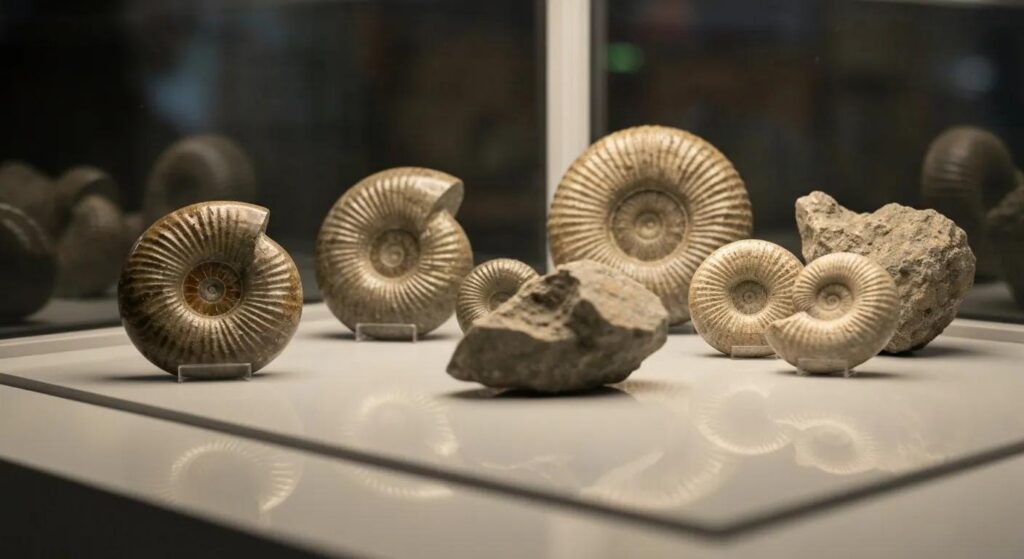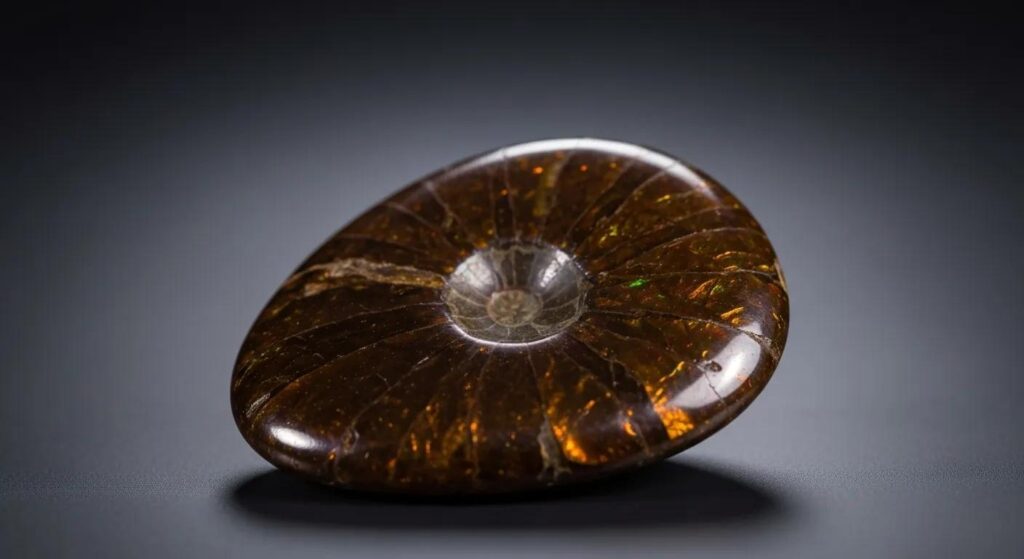Discover Authentic Ammonite Fossils: Origins, Types & Collecting
Explore & Buy Authentic Ammonite Fossils: Types, Origins & Collecting

Imagine holding a piece of Earth’s ancient past, a spiral-shelled marvel that whispers tales from 100 million years ago. Ammonite fossils offer just that—a captivating blend of scientific intrigue and striking natural art, perfect for any gemstone enthusiast or discerning collector. In this comprehensive guide, we’ll journey deep into the mesmerizing world of these magnificent marine cephalopods. You’ll uncover what makes these timeless treasures so profoundly valuable, explore the diverse varieties available—from exquisitely polished display pieces to raw, untouched specimens and the dazzling iridescence of ammolite gemstones. We’ll reveal their global origins, equip you with the essential knowledge to authenticate them, and share expert tips for their meticulous care and stunning display. And, of course, we’ll seamlessly weave in insights on sourcing from Mayhem Canyon Mineral Co., guiding you to our curated gemstone collection (https://mayhemcanyon.com/gemstones/) so you can confidently expand your fossil repertoire with pieces that truly resonate with your unique style and passion.
What Are Ammonite Fossils and Why Do They Captivate Collectors?
Ammonite fossils are the mineralized echoes of extinct marine molluscs from the Mesozoic Era, enchanting collectors with their perfectly spiraled chambers and, in some rare cases, a breathtaking, almost otherworldly iridescence. These remarkable specimens formed over eons as organic tissues gracefully decomposed, allowing minerals like calcite or aragonite to slowly, meticulously fill their intricate chambers. This delicate, miraculous process preserved the shell’s mesmerizing suture patterns in stone. Picture a polished Jurassic ammonite: its internal septa reveal themselves as fine, elegant lines, tracing the ancient creature’s growth—a testament to both profound paleontological significance and undeniable aesthetic allure. Understanding their ancient origin and the miraculous process of their preservation illuminates why collectors so deeply prize ammonites, not just for display, but as tangible investments in Earth’s deep history. This sets the stage for us to explore the specific types you can acquire and how to source them with absolute confidence.
The Ancient Art of Ammonite Fossil Formation and Mineralization
Ammonite fossils are born when the original organic shell material is meticulously replaced by minerals such as calcite or aragonite, preserving every intricate suture pattern with astonishing fidelity. This profound geological process transforms the original animal into a stunning stone replica, offering invaluable insights into Earth‘s deep history and serving as a true masterpiece of natural artwork.
This research beautifully supports our explanation of how ammonite fossils are created and underscores the profound significance of their mineralization process.
What Exactly Is an Ammonite Fossil?
An ammonite fossil is a perfectly preserved remnant of an ammonoid, an extinct cephalopod renowned for its elegant planispiral shell, ingeniously divided into gas-filled chambers for precise buoyancy control. Each chamber’s boundary, known as a suture line, showcases complex, fractal-like patterns, utterly unique to its genus and species. Over countless millennia, sediment gently infiltrated these shells, replacing the organic material with minerals and creating a stone replica that is both a captivating geological narrative and a natural work of art. This incredible mechanism yields specimens that not only tell a profound story of Earth’s past but also stand as exquisite sculptures. From this definition, let’s journey back in time to understand their ancient chronology.
How Old Are Ammonite Fossils and What Geological Periods Do They Represent?
Ammonite fossils span an astonishing timeline, from the Devonian Period (a staggering 400 million years ago) right through to the Cretaceous Period (ending 66 million years ago), reaching their peak diversity and grandeur during the Jurassic and early Cretaceous eras. The table below offers a captivating glimpse into these pivotal periods and the distinctive features of the ammonites that thrived within them:
| Entity | Attribute | Value |
|---|---|---|
| Jurassic | Time span | 201–145 million years ago |
| Common genera | Cleoniceras, Stephanoceras | |
| Cretaceous | Time span | 145–66 million years ago |
| Notable species | Parapuzosia seppenradensis | |
| Devonian | First appearance | ~400 million years ago |
| Triassic | Post-extinction rise | Diversification after Permian collapse |
These ancient eras imbue each specimen with a rich, profound geological context, elevating its scientific and collectible value. This deep history naturally leads us to explore the specific traits that make collectors so passionate about these timeless treasures.
What Makes Ammonite Fossils So Prized by Discerning Collectors?
Collectors cherish ammonite fossils for a captivating blend of rarity, completeness, exceptional preservation quality, and stunning visual features like iridescence. Perfectly preserved specimens, boasting intact suture patterns and original shell aragonite, consistently command premium prices. Larger, truly awe-inspiring examples, such as the magnificent Parapuzosia species, showcase extraordinary scale and commanding presence. Then there’s the iridescent ammolite—an organic gemstone born from these ancient shells—which dazzles with vivid reds, greens, and blues, adding an unparalleled gemstone appeal. Understanding these key value drivers empowers you to select pieces that not only offer breathtaking aesthetic display but also hold significant investment potential, naturally guiding you to the diverse types available for your collection.
Which Types of Ammonite Fossils Can You Discover and Buy?


The world of ammonite fossils is wonderfully diverse, offering a variety of forms, each promising distinct display benefits and a truly unique collecting experience. From the mesmerizing polished cross-sections that unveil their intricate spiral chambers to raw, untouched nodules perfect for authentic scientific exploration, and the truly rare ammolite cabochons prized as exquisite gemstones—there’s a perfect specimen waiting to captivate every collector’s heart and taste.
What Are Polished Ammonite Fossils and How Do They Enhance Your Space?
Polished ammonite fossils are meticulously cut and buffed to reveal the breathtaking internal spiral and chamber structure, often elegantly mounted on clear acrylic stands or encased in gleaming resin. This meticulous polishing process brilliantly accentuates the delicate suture details and the rich surface color variations of their calcite-filled chambers, transforming them into ideal focal points for mantels, shelves, and display cabinets. As decorative centerpieces, these specimens effortlessly blend profound natural history with the warm, earthy tones of Southwestern décor, offering collectors a sophisticated way to highlight both geological wonder and refined interior design.
What Are Raw and Natural Ammonite Fossils?
Raw ammonite fossils are untouched nodules or partially exposed shells that proudly retain their natural weathered matrix and original exterior surface. They are highly prized for authentic study, as their original sedimentary context remains perfectly intact, allowing for invaluable geological assessments of their formation and diagenesis. Enthusiasts who deeply appreciate paleontological authenticity often choose to present raw pieces alongside magnification tools, inviting a closer examination of growth lines and shell texture. This creates a more tactile and immersive collecting experience, a true glimpse into the past before moving on to the more refined beauty of polished displays.
What Is Ammolite and How Does It Differ from Regular Ammonite Fossils?

Ammolite is an extraordinary, opal-like organic gemstone, born when the aragonite layers within select ammonite shells from Alberta, Canada’s Bearpaw Formation undergo a unique mineralization process, producing an astonishing play-of-color. Unlike standard ammonite fossils, whose chambers fill with minerals like calcite or pyrite, ammolite specimens preserve these iridescent mineral sheets that magically refract light into a symphony of vibrant hues. Collectors hold ammolite in dual reverence—as both a profound fossil relic and an exceptionally rare gemstone, perfectly suited for exquisite jewelry, dazzling cabochons, and intricate inlay work.
Where Is Ammolite Found and What Are Its Unique Properties?
Ammolite is found almost exclusively within the ancient Bearpaw Formation of southern Alberta, Canada. Here, unique fine-grained sediment and post-depositional conditions conspired to perfectly preserve the aragonite’s delicate layered structure. Its breathtaking color spectrum spans fiery reds, warm oranges, sunny yellows, lush greens, deep blues, and regal purples, graded (AA to AAA) by the intensity of its hue, clarity, and relief. These exceptional properties make AAA-grade ammolite incredibly rare, commanding significant value in the gemstone market and enhancing any fossil collection with its unparalleled, living gemstone vibrancy.
The Magic of Ammolite Formation and Its Dazzling Properties
Ammolite, a truly unique gemstone born from ancient ammonite shells, is exclusively formed within the Bearpaw Formation of Alberta, Canada. The extraordinary geological conditions in this region perfectly preserved the aragonite layers, which then create its mesmerizing play-of-color effect. This rare phenomenon is precisely what makes ammolite such a valuable and sought-after gemstone.
This citation offers deeper insights into the fascinating formation and unique properties of ammolite, further enriching our understanding of this remarkable gemstone.
Where Do These Ancient Wonders Emerge Around the World?
Collectible ammonite fossils emerge from ancient sedimentary basins across five continents, each unique locality contributing distinctive species, preservation types, and market availability. From the dramatic, fossil-rich cliffs of southern England to the sun-drenched phosphate mines of Morocco, the geographic origin profoundly shapes both the scientific context and the fervent demand from collectors.
What Are the Most Famous Ammonite Fossil Locations?
Embark on a global journey to discover the prominent sites where these ancient treasures are unearthed:
- Madagascar: Renowned for yielding vibrant, often beautifully cracked nodules filled with calcite, frequently replaced by intricate dendritic minerals.
- Morocco: A prolific source of numerous small to medium specimens, many expertly polished to reveal their inner beauty for display.
- Germany: The legendary home of Parapuzosia seppenradensis, one of the largest and most awe-inspiring ammonites ever discovered.
- England (JurassicCoast): An iconic stretch of coastline, famous for its well-defined nodules with perfectly preserved chambers, often found along its historic Dorset beaches.
Exploring these diverse regions reveals how each source contributes distinctive species and preservation styles, setting the stage for a deeper understanding of why Alberta stands out as the exclusive home of ammolite.
Why Is Alberta, Canada So Crucial for Ammolite Gemstones?
Alberta’s Bearpaw Formation provided the perfect sedimentary and diagenetic conditions that miraculously preserved ammonite shell aragonite in microscopically thin layers—a critical factor for the breathtaking iridescent play-of-color. This exclusive locality is the world’s primary source of commercial ammolite, offering collectors unparalleled access to organic gemstones that seamlessly combine profound paleontological heritage with dazzling gemological brilliance. This unique connection further underscores Mayhem Canyon’s unwavering commitment to ethically sourced, exceptional specimens.
How Do Geographic Origins Influence Ammonite Fossil Value?
Regional differences in geology and taphonomy profoundly influence a fossil’s color, size, and completeness. Madagascan ammonites, for instance, often feature vibrant calcite fills, while Moroccan pieces may display intricate pyrite coatings. Alberta ammolite’s unparalleled iridescence commands gemstone-level prices, whereas German Parapuzosia specimens are valued for their monumental scale and extreme rarity. Recognizing these origin-based attributes empowers collectors to accurately assess value and perfectly match specimens to their personal preferences, ultimately building a truly well-rounded and meaningful collection.
How to Identify and Authenticate Your Ammonite Fossils?
Authenticating ammonite fossils is a crucial step that requires a keen eye for detail, examining shell structure, suture complexity, and mineral composition to confidently distinguish genuine specimens from clever replicas or composites. This meticulous attention ensures you acquire true paleontological artifacts, not mere reproductions, safeguarding your investment and passion.
What Are the Key Features to Identify a Genuine Ammonite Fossil?
Genuine ammonites reveal their authenticity through several unmistakable features:
- Complex suturepatterns that follow intricate fractal geometry, utterly unique to specific ammonoid genera.
- Shell curvature and ribbing that are perfectly consistent with known species descriptions.
- Mineralfill composition—be it calcite, aragonite, or pyrite—that precisely matches its geological source.
- Natural matrix adhesion on raw specimens, clearly showing authentic sediment contact.
These diagnostic attributes build unwavering confidence in your purchases and serve as your shield against misidentified or artificially assembled pieces. From here, it’s essential to differentiate them from other, similar cephalopods.
How to Differentiate Ammonites from Nautilus and Other Cephalopods?
While both ammonites and modern nautiluses share the elegant planispiral shell, ammonites are distinguished by their far more elaborate and complex suture lines, whereas nautilussutures are notably simple and straight. Nautilus shells often boast a smooth, glossy mother-of-pearl interior, a stark contrast to the mineral-filled chambers characteristic of ammonites. Recognizing these distinct meristic and morphological differences is key to preventing misclassification and ensuring the accuracy and integrity of your collection.
What Are Common Signs of Fake or Reconstructed Ammonite Fossils?
As a savvy collector, be vigilant for these tell-tale signs of inauthenticity:
- Uniform coloration that lacks natural variation and depth.
- Visible resin or plaster seams around the shell edges, indicating assembly.
- Identical suture patterns repeated across multiple specimens, strongly suggesting the use of molds.
- Sharp, unnatural tool marks or fractures that don’t align with natural formation.
Spotting these red flags empowers you to confidently avoid deceptive offerings and focus your passion on credible specimens, ideally backed by clear provenance documentation.
How to Care for and Display Your Cherished Ammonite Fossils?
Proper care is paramount to preserving your ammonite fossils’ structural integrity and timeless beauty, while thoughtful display transforms them into captivating geological charms within your home décor or gallery settings. Treat these ancient wonders with the respect they deserve, and they will continue to inspire for generations.
What Are Best Practices for Cleaning and Preserving Ammonite Fossils?
To ensure the longevity of your precious ammonite fossils, clean them gently with a soft brush and distilled water, carefully removing dust without scratching their polished surfaces. Crucially, avoid acidic cleaners, which can dissolve delicate calcite or aragonite. For raw pieces, consider consolidating any friable matrix with a diluted, reversible consolidant. Always store your specimens in stable humidity and temperature conditions to prevent cracking, naturally leading us to explore creative and inspiring display solutions.
How Can You Display Ammonite Fossils to Enhance Their Beauty?
To truly showcase their splendor, utilize clear acrylic stands or custom metal mounts that allow their intricate spiral geometry to be admired from every angle. For translucent ammolite, back-lighting magically highlights its vibrant play-of-color, while shadow boxes with museum-grade glass offer elegant protection against dust. For a cohesive and captivating look, pair your ammonites with other Southwestern décor elements—like polished agate slabs or vibrant turquoise—creating a signature style that beautifully blends geological wonder with sophisticated interior design.
What Are Popular Ammonite Fossil Display Ideas for Collectors?
Discerning collectors often feature their ammonites in truly inspiring ways:
- Mounted wall panels showcasing multiple cross-sections in graduated sizes, creating a stunning visual narrative.
- Glass-topped coffee tables with embedded raw specimens, inviting conversation and discovery.
- Floating shelves elegantly lined with polished ammonites and exquisite ammolite brooches, transforming a space into a personal gallery.
These thoughtfully curated arrangements elevate fossil collections into captivating conversational art pieces, fostering a deeper appreciation for both natural history and refined interior style.
What Are the Most Notable Ammonite Species and Their Unique Characteristics?
Among the vast array of ammonoid species, some truly stand out for their monumental size, extreme rarity, or distinct morphology, offering compelling focal points for specialized and truly unique collections.
What Are Large Ammonite Species Like Parapuzosia seppenradensis?
Parapuzosia seppenradensis holds the awe-inspiring record as the largest known ammonite species, reaching diameters of over 2 meters. Its robust, coarse ribs and broad whorls reflect its adaptation to the vast, open-ocean life of the ancient seas. Fossils of this colossal scale are exceedingly rare and often incomplete, typically residing in prestigious museum holdings. Consequently, even fragments of Parapuzosia carry immense scientific and monetary value, inspiring collectors to seek out smaller, yet still impressive, accessible giants for their own collections.
What Are Distinctive Features of Cleoniceras and Other Common Genera?
Genera like Cleoniceras captivate with their delicate, closely spaced ribs and moderately evolute whorls. Their beautifully defined sutures and manageable sizes (typically 5–15 cm in diameter) make them exceptionally popular as polished display pieces. Other common genera, such as Stephanoceras and Perisphinctes, exhibit fascinating rib bifurcations and distinctive keel structures, adding unique sculptural interest and character to each specimen.
How Do Species Differences Influence Fossil Value and Appeal?
Species boasting bold ornamentation, impressive size, or rare iridescence consistently command higher prices in the market. For instance, even fragments of a colossal Parapuzosia can outprice a complete, smaller Cleoniceras. Similarly, AAA-graded ammolite, valued for its species rarity, yields premium gemstone rates—underscoring how a specimen’s taxonomic identity profoundly shapes both its aesthetic allure and its investment appeal.
How Much Are Ammonite Fossils Worth and What Affects Their Price?
The value of ammonite fossils spans a wide spectrum, from accessible pieces like small Moroccan nodules, which might be around $20, to museum-quality or exceptionally large specimens that can command six-figure sums. Understanding the key factors—including size, completeness, preservation, rarity, and locality—is essential for weaving smart transactional considerations into your collecting strategy.
What Factors Determine the True Value of Ammonite Fossils?
The true value of an ammonite fossil is driven by several critical factors:
- Size and completeness—larger, unbroken shells are always in higher demand.
- Preservation quality—vivid suture visibility and perfectly intact whorls fetch premium prices.
- Speciesrarity—unique genera or exceptionally large specimens command higher bids.
- Geographic origin—Alberta ammolite and German Parapuzosia are particularly prized for their distinct qualities.
- Iridescence—ammonites exhibiting natural, vibrant color play stand out as true market gems.
Understanding these intricate factors empowers you to confidently compare listings and invest wisely in additions that enhance both the visual splendor of your display and the long-term value of your collection.
How Does Ammolite Pricing Compare to Regular Ammonite Fossils?
Ammolite prices are uniquely driven by rigorous gemstone grading systems and the robust market demand for organic opals. A stunning AAA-grade ammolite cabochon can easily exceed $200 per carat, whereas a polished calcite ammonite disc of similar size might range from $50 to $300, depending on its origin and the craftsmanship involved. This significant transactional contrast beautifully highlights ammolite’s dual and highly coveted role as both a profound fossil and an exquisite gemstone.
Where Can You Buy Authentic Ammonite Fossils Online?
At Mayhem Canyon Mineral Co., we pride ourselves on offering a meticulously curated selection of ethically sourced ammonite specimens. From beautifully polished Madagascar slices to the unparalleled brilliance of AAA-grade Alberta ammolite, our collection is designed to inspire. Explore our dedicated gemstone collection (https://mayhemcanyon.com/gemstones/) featuring exquisite loose ammolite cabochons and custom jewelry settings. By partnering directly with local miners and upholding transparent supply chains, we guarantee both authenticity and exceptional quality—so you can shop with absolute confidence, knowing you’re acquiring a true piece of Earth’s history.
What Are Common Questions About Ammonite Fossils?
Collectors often find themselves pondering the availability of these ancient wonders, the fascinating differences between ammonites and their modern cephalopod relatives, and the extraordinary records set by monumental finds. Addressing these intriguing themes helps to demystify the art of collecting while guiding you toward truly informed purchases.
- Many enthusiasts frequently inquire about the rarity of ammonite fossils, as preservation conditions varied dramatically across geological periods and diverse locales.
- Drawing comparisons between ammonites and living nautiluses beautifully clarifies their structural distinctions and illuminates their profound evolutionary relationships.
- Understanding the intricate fossilization processes—from the initial shell burial to the miraculous mineral replacement—sheds light on how these specimens retain such astonishing morphological detail.
- Natural history buffs are often captivated by record-setting finds, such as the largest ammonite ever documented, fostering a deeper appreciation for the sheer scale and incredible diversity of these ancient creatures.
These narrative touchpoints are designed to build your collector confidence and seamlessly lead into how Mayhem Canyon upholds its unwavering standards of quality and authenticity.
How Does Mayhem Canyon Ensure the Quality and Authenticity of Ammonite Fossils?
At Mayhem Canyon, our commitment to excellence is unwavering. We combine decades of passionate mineral-collecting experience with rigorous sourcing protocols to deliver only genuine, museum-grade ammonite specimens and the most iridescent ammolite gemstones. Your trust is our treasure.
What Are Mayhem Canyon’s Unique Value Propositions for Ammonite Collectors?
Our promise to you is built on unparalleled guarantees:
- Provenance documentation for every single specimen, linking your treasure directly to its precise excavation site.
- Third-party mineralassays meticulously confirming composition and age, ensuring absolute authenticity.
- Competitive pricing made possible by our direct, ethical partnerships with miners, passing savings directly to you.
- Curated variety spanning polished, raw, and exquisite gemstone formats, offering something truly special for every collector.
This profound commitment to transparency not only reinforces your trust but also firmly positions our offerings as truly superior collectibles, unmatched in quality and integrity.
How Does Mayhem Canyon Source Ammonite Fossils Ethically?
Our dedication to ethical sourcing is at the heart of everything we do. We partner exclusively with suppliers who rigorously adhere to local mining regulations and deeply respect land-use agreements. By thoughtfully investing in small-scale operations and actively supporting community development, we minimize our ecological impact while ensuring fair compensation for the dedicated workers. This ethical approach not only preserves precious fossil sites for future generations of collectors and researchers but also fosters a sustainable and responsible trade.
What Customer Support and Educational Resources Does Mayhem Canyon Offer?
Mayhem Canyon is committed to empowering your collecting journey, providing a wealth of resources:
- Free identification guides and comprehensive care manuals, conveniently downloadable from our site.
- Live chat assistance for personalized specimen selection and expert answers to your geological questions.
- Engaging video tutorials on the best practices for cleaning, mounting, and displaying your fossils in stunning Southwestern décor settings.
- An exclusive Collector’s newsletter brimming with invaluable market insights, exciting new arrivals, and special offers just for you.
These comprehensive resources are designed to empower both novice and seasoned collectors, enabling you to expand your ammonite collections with unwavering confidence and joy.
Collecting ammonite fossils is a profound journey that beautifully merges scientific heritage with artistic expression. With the strategic insights gleaned from this guide—and perfectly paired with Mayhem Canyon’s meticulously curated offerings—you are now fully equipped to build a collection that magnificently reflects both the boundless wonder of geology and your own distinctive personal style.
